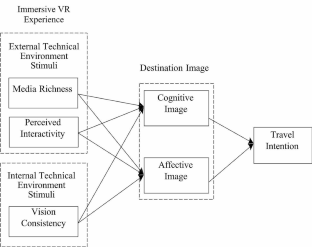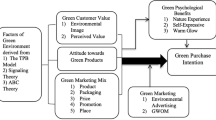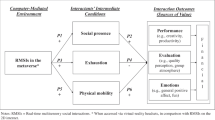Abstract
This study investigates the relationship between the immersive VR experience, destination cognitive image, destination affective image, and tourists’ travel intention. The sample of this research is 167 visitors of three tourist attractions of Isfahan Province in Iran, through 360-degree virtual reality videos. In order to collect research data, an online survey and convenience sampling methods were used. PLS-SEM was utilized to assess both the measurement and structural models. The findings indicated that among factors of external technical environment stimuli, media richness has a stronger effect on the formation of the destination’s cognitive image than the affective image. Also, perceived interactivity compared to media richness has a significant impact on the formation of the destination’s affective image. In addition, vision consistency as an internal technical environment stimulus has a positive effect on the formation of the cognitive and affective image of the destination. Finally, the affective image of the destination resulting from the immersive VR experience has a stronger effect on travel intention than the cognitive image.


Similar content being viewed by others
References
Akgün, A. E., Senturk, H. A., Keskin, H., & Onal, I. (2020). The relationships among nostalgic emotion, destination images and tourist behaviors: An empirical study of Istanbul. Journal of Destination Marketing & Management, 16, 100355.
An, S., Choi, Y., & Lee, C. K. (2021). Virtual travel experience and destination marketing: Effects of sense and information quality on flow and visit intention. Journal of Destination Marketing & Management,19, 100492.
Assaker, G. (2020). Age and gender differences in online travel reviews and user-generated-content (UGC) adoption: Extending the technology acceptance model (TAM) with credibility theory. Journal of Hospitality Marketing & Management, 29(4), 428–449.
Baron, R. M., & Kenny, D. A. (1986). The moderator-mediator variable distinction in social research: Conceptual, strategic, and statistical considerations. Journal of personality and social psychology, 51(6), 1173–1182.
Chang, H. H., & Chiang, C. C. (2022). Is virtual reality technology an effective tool for tourism destination marketing? A flow perspective. Journal of Hospitality and Tourism Technology, 13(3), 427–440.
Chen, C. C., & Chang, Y. C. (2018). What drives purchase intention on Airbnb? Perspectives of consumer reviews, information quality, and media richness. Telematics and Informatics, 35(5), 1512–1523.
Chew, E. Y. T., & Jahari, S. A. (2014). Destination image as a mediator between perceived risks and revisit intention: A case of post-disaster Japan. Tourism Management, 40(1), 382–393.
Chu, Q., Bao, G., & Sun, J. (2022). Progress and prospects of destination image research in the last decade. Sustainability, 14(17), 10716.
de Amorim, I. P., Guerreiro, J., Eloy, S., & Loureiro, S. M. C. (2022). How augmented reality media richness influences consumer behaviour. International Journal of Consumer Studies, 46(6), 2351–2366.
Dincelli, E., & Yayla, A. (2022). Immersive virtual reality in the age of the Metaverse: A hybrid-narrative review based on the technology affordance perspective. The Journal of Strategic Information Systems, 31(2), 101717.
Elbedweihy, A. M., Jayawardhena, C., Elsharnouby, M. H., et al. (2016). Customer relationship building: The role of brand attractiveness and consumer–brand identification. Journal of Business Research, 69(8), 2901–2910.
Flavián, C., Ibáñez-Sánchez, S., & Orús, C. (2021). Impacts of technological embodiment through virtual reality on potential guests’ emotions and engagement. Journal of Hospitality Marketing & Management, 30(1), 1–20.
Gartner, W. C. (1994). Image formation process. Journal of Travel & Tourism Marketing, 2(2–3), 191–216.
Ghorbanzadeh, D. (2022). Relationships between virtual reality experiences, experiential relationship quality and experiential advocacy: The case of virtual reality park. Journal of Relationship Marketing, 21(3), 169–193.
González-Rodríguez, M. R., Díaz-Fernández, M. C., & Pino-Mejías, M. Á. (2020). The impact of virtual reality technology on tourists’ experience: A textual data analysis. Soft Computing, 24(18), 13879–13892.
Guerreiro, J., Rita, P., & Trigueiros, D. (2015). Attention, emotions and cause-related marketing effectiveness. European Journal of Marketing, 49(11/12), 1728–1750.
Guo, K., Fan, A., Lehto, X., & Day, J. (2023). Immersive digital tourism: The role of multisensory cues in digital museum experiences. Journal of Hospitality & Tourism Research, 47(6), 1017–1039.
Hair, J. F., Risher, J. J., Sarstedt, M., & Ringle, C. M. (2019). When to use and how to report the results of PLS-SEM. European Business Review, 31(1), 2–24.
Hyun, M. Y., & O'Keefe, R. M. (2012). Virtual destination image: Testing a Telepresence model, Journal of Business Research, 65(1), 29–35.
Ijsselsteijn, W. A. (2002). Elements of a multi-level theory of presence: Phenomenology, mental processing and neural correlates. Proceedings of presence,2002, 245–259.
Kaushik, A. K., Mohan, G., & Kumar, V. (2020). Examining the antecedents and consequences of customers’ trust toward mobile retail apps in India. Journal of Internet Commerce, 19(1), 1–31.
Kim, M. J., Lee, C. K., & Jung, T. (2020). Exploring consumer behavior in virtual reality tourism using an extended stimulus-organism-response model. Journal of Travel Research, 59(1), 69–89.
Lee, S. A., Lee, M., & Jeong, M. (2021). The role of virtual reality on information sharing and seeking behaviors. Journal of Hospitality and Tourism Management, 46, 215–223.
Lin, L. P. L., Huang, S. C. L., & Ho, Y. C. (2020). Could virtual reality effectively market slow travel in a heritage destination? Tourism Management, 78, 104027.
Loureiro, S. M. C., Guerreiro, J., Eloy, S., et al. (2019). Understanding the use of virtual reality in marketing: A text mining-based review. Journal of Business Research, 100, 514–530.
Makransky, G., & Mayer, R. E. (2022). Benefits of taking a virtual field trip in immersive virtual reality: Evidence for the immersion principle in multimedia learning. Educational Psychology Review, 34(3), 1771–1798.
McLean, G., & Wilson, A. (2019). Shopping in the digital world: Examining customer engagement through augmented reality mobile applications. Computers in Human Behavior, 101, 210–224.
Moon, J. H., Kim, E., Choi, S. M., et al. (2013). Keep the Social in Social Media: The role of Social Interaction in Avatar-based virtual shopping. Journal of Interactive Advertising, 13(1), 14–26.
Mütterlein, J., & Hess, T. (2017). Exploring the impacts of virtual reality on business models: the case of the media industry.
Nazir, M. U., Yasin, I., Tat, H. H., Khalique, M., & Mehmood, S. A. (2022). The influence of international tourists’ destination image of Pakistan on behavioral intention: The roles of travel experience and media exposure. International Journal of Hospitality & Tourism Administration, 23(6), 1266–1290.
Pan, X., Rasouli, S., & Timmermans, H. (2021). Investigating tourist destination choice: Effect of destination image from social network members. Tourism Management, 83, 104217.
Podsakoff, P. M., MacKenzie, S. B., Lee, J. Y., & Podsakoff, N. P. (2003). Common method biases in behavioral research: a critical review of the literature and recommended remedies. Journal of Appelied Psychology, 88(5), 879–903.
Qu, H., Kim, L. H., & Im, H. H. (2011). A model of destination branding: Integrating the concepts of the branding and destination image. Tourism Management, 32(3), 465–476.
Rahimizhian, S., Ozturen, A., & Ilkan, M. (2020). Emerging realm of 360-degree technology to promote tourism destination. Technology in Society, 63, 101411.
Rainoldi, M., Driescher, V., Lisnevska, A., Zvereva, D., Stavinska, A., Relota, J., & Egger, R. (2018). Virtual reality: an innovative tool in destinations' marketing. The Gaze: Journal of Tourism and Hospitality, 9(1), 53–68.
Russell, J. A., Ward, L. M., & Pratt, G. (1981). Affective quality attributed to environments: A factor analytic study. Environment and Behavior, 13(3), 259–288.
Tahyudin, I., Saputra, D. I. S., & Haviluddin, H. (2015). An interactive mobile augmented reality for tourism objects at Purbalingga district. TELKOMNIKA Indonesian Journal of Electrical Engineering, 16(3), 559–564.
Tiusanen, P. (2017). Virtual reality in destination marketing.
Vishnevskaya, E. V., Klimova, T. B., Slinkova, O. K., & Glumova, Y. G. (2017). The influence of virtual information spaces on tourism development. Espacios, 38(49), 22.
Woyo, E., & Nyamandi, C. (2022). Application of virtual reality technologies in the comrades’ marathon as a response to COVID-19 pandemic. Development Southern Africa, 39(1), 20–34.
Wu, X., & Lai, I. K. W. (2021). Identifying the response factors in the formation of a sense of presence and a destination image from a 360-degree virtual tour. Journal of Destination Marketing & Management, 21, 100640.
Yang, S., Carlson, J. R., & Chen, S. (2020). How augmented reality affects advertising effectiveness: The mediating effects of curiosity and attention toward the ad. Journal of Retailing and Consumer Services, 54, 102020.
Yang, R,. Khloo-Lattimore, C., & Potter, L. E. (2021). Virtual reality and tourism marketing: Conceptualizing a framework on presence, emotion, and intention. Current Issues in Tourism, 24(11), 1505–1525.
Yilmaz, Y., & Yilmaz, Y. (2020). Pre-and post‐trip antecedents of destination image for non‐visitors and visitors: A literature review. International Journal of Tourism Research, 22(4), 518–535.
Ying, T., Tang, J., Ye, S., Tan, X., & Wei, W. (2022). Virtual reality in destination marketing: Telepresence, social presence, and tourists’ visit intentions. Journal of Travel Research, 61(8), 1738–1756.
Zhang, C. (2020). The why, what, and how of immersive experience. Ieee Access, 8, 90878–90888.
Zhang, M., Zhang, G. Y., Gursoy, D., & Fu, X. R. (2018). Message framing and regulatory focus effects on destination image formation. Tourism Management, 69, 397–407.
Author information
Authors and Affiliations
Corresponding author
Ethics declarations
Conflict of interest
No potential conflict of interest was reported by the author(s).
Additional information
Publisher’s Note
Springer Nature remains neutral with regard to jurisdictional claims in published maps and institutional affiliations.
Rights and permissions
Springer Nature or its licensor (e.g. a society or other partner) holds exclusive rights to this article under a publishing agreement with the author(s) or other rightsholder(s); author self-archiving of the accepted manuscript version of this article is solely governed by the terms of such publishing agreement and applicable law.
About this article
Cite this article
Ghorbanzadeh, D., AlHamad, A.Q.M., Deng, K.Y. et al. Enhancing destination image through virtual reality technology: the role of tourists’ immersive experience. Curr Psychol (2024). https://doi.org/10.1007/s12144-024-06007-3
Accepted:
Published:
DOI: https://doi.org/10.1007/s12144-024-06007-3




